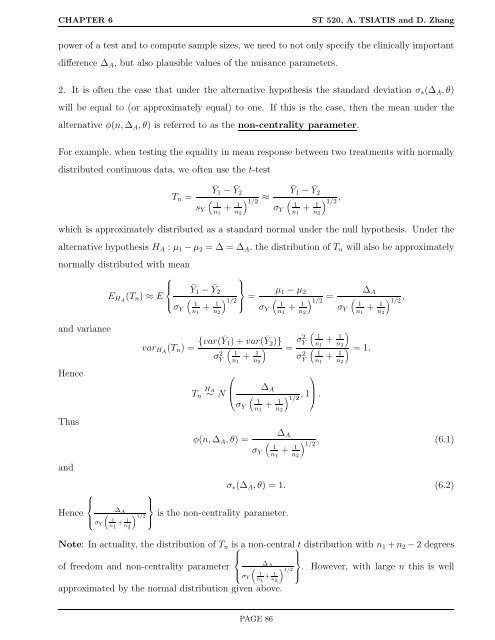ST 520 Statistical Principles of Clinical Trials - NCSU Statistics ...
ST 520 Statistical Principles of Clinical Trials - NCSU Statistics ...
ST 520 Statistical Principles of Clinical Trials - NCSU Statistics ...
You also want an ePaper? Increase the reach of your titles
YUMPU automatically turns print PDFs into web optimized ePapers that Google loves.
CHAPTER 6 <strong>ST</strong> <strong>520</strong>, A. TSIATIS and D. Zhang<br />
power <strong>of</strong> a test and to compute sample sizes, we need to not only specify the clinically important<br />
difference ∆A, but also plausible values <strong>of</strong> the nuisance parameters.<br />
2. It is <strong>of</strong>ten the case that under the alternative hypothesis the standard deviation σ∗(∆A, θ)<br />
will be equal to (or approximately equal) to one. If this is the case, then the mean under the<br />
alternative φ(n, ∆A, θ) is referred to as the non-centrality parameter.<br />
For example, when testing the equality in mean response between two treatments with normally<br />
distributed continuous data, we <strong>of</strong>ten use the t-test<br />
Tn =<br />
sY<br />
¯Y1 − ¯ Y2<br />
� ≈ 1/2<br />
1 + n1 n2<br />
� 1<br />
σY<br />
¯Y1 − ¯ Y2<br />
� , 1/2<br />
1 + n1 n2<br />
which is approximately distributed as a standard normal under the null hypothesis. Under the<br />
alternative hypothesis HA : µ1 −µ2 = ∆ = ∆A, the distribution <strong>of</strong> Tn will also be approximately<br />
normally distributed with mean<br />
and variance<br />
Hence<br />
Thus<br />
and<br />
⎧<br />
⎪⎨<br />
Hence<br />
⎪⎩<br />
EHA (Tn)<br />
⎧<br />
⎪⎨<br />
≈ E<br />
⎪⎩<br />
∆A �<br />
1<br />
σY + n1 1<br />
n2 σY<br />
¯Y1 − ¯ Y2<br />
� 1<br />
n1<br />
+ 1<br />
n2<br />
� 1/2<br />
⎫<br />
⎪⎬<br />
⎪⎭ =<br />
σY<br />
� 1<br />
µ1 − µ2<br />
�<br />
1<br />
varHA (Tn) = {var(¯ Y1) + var( ¯ Y2)}<br />
σ2 � � =<br />
1 1<br />
Y + n1 n2<br />
σ2 Y<br />
σ2 Y<br />
⎛<br />
n1<br />
� = 1/2<br />
1<br />
+ n2<br />
� 1<br />
n1 �<br />
1<br />
⎞<br />
n1<br />
HA ⎜ ∆A ⎟<br />
Tn ∼ N ⎝ � � , 1 1/2 ⎠.<br />
1 1<br />
σY + n1 n2<br />
φ(n, ∆A, θ) =<br />
σY<br />
� 1<br />
n1<br />
∆A<br />
σY<br />
� 1<br />
n1<br />
∆A<br />
�<br />
1 + n2�<br />
= 1.<br />
1 + n2<br />
� , 1/2<br />
1<br />
+ n2<br />
� , (6.1)<br />
1/2<br />
1 + n2<br />
⎫<br />
⎪⎬<br />
σ∗(∆A, θ) = 1. (6.2)<br />
�1/2 is the non-centrality parameter.<br />
⎪⎭<br />
Note: In actuality, the distribution <strong>of</strong> Tn is ⎧a<br />
non-central t distribution with n1 +n2 −2 degrees<br />
⎪⎨<br />
∆A<br />
<strong>of</strong> freedom and non-centrality parameter �<br />
⎪⎩ 1<br />
σY +<br />
n1 1<br />
⎫<br />
⎪⎬<br />
�1/2 . However, with large n this is well<br />
⎪⎭<br />
n2 approximated by the normal distribution given above.<br />
PAGE 86
















